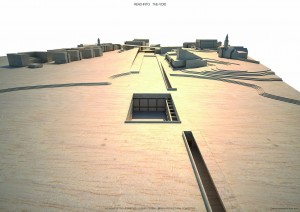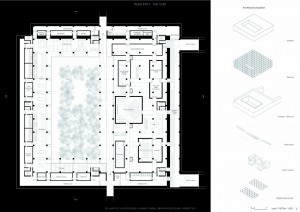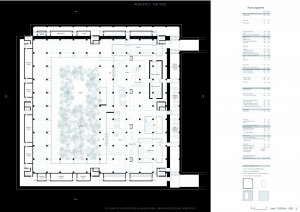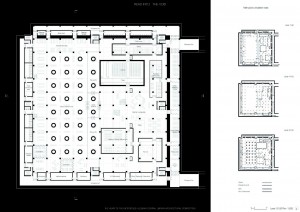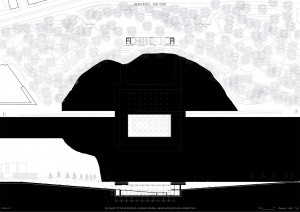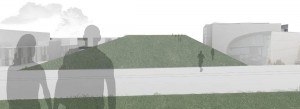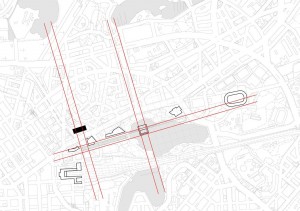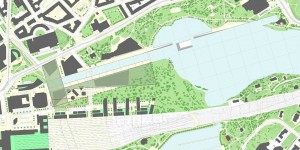La biblioteca è per natura un “foro”: il luogo pubblico dove si conservano i libri.
Per potersi dedicare al culto del libro: la lettura.
Ma qui , essendo un foro anche letteralmente, si esalta la condizione di luogo “escluso” per divenire interno puro. E perciò essere fatto interiore. Simbolo del pensiero e delle affezioni interiori che ospiterà nel momento in cui i lettori lo faranno tale.
Per questo ho parlato di architetura tettonica, come buco nella terra. S’intitola infatti The Earth of the metropolis. Ma anche Read-into-the-void. È per una lettura protetta dal rumore intorno e che trasporta in untempospazio altro che si buca terra. E se ne fa l’interno puro di uno spazio “ideale”, astratto, concettuale qualificata da una musica spaziale basata sull’accordo tonale, il rapporto tra 1 e 2 per cui il doppio o la metà regolano l’armonia della “partitura”.
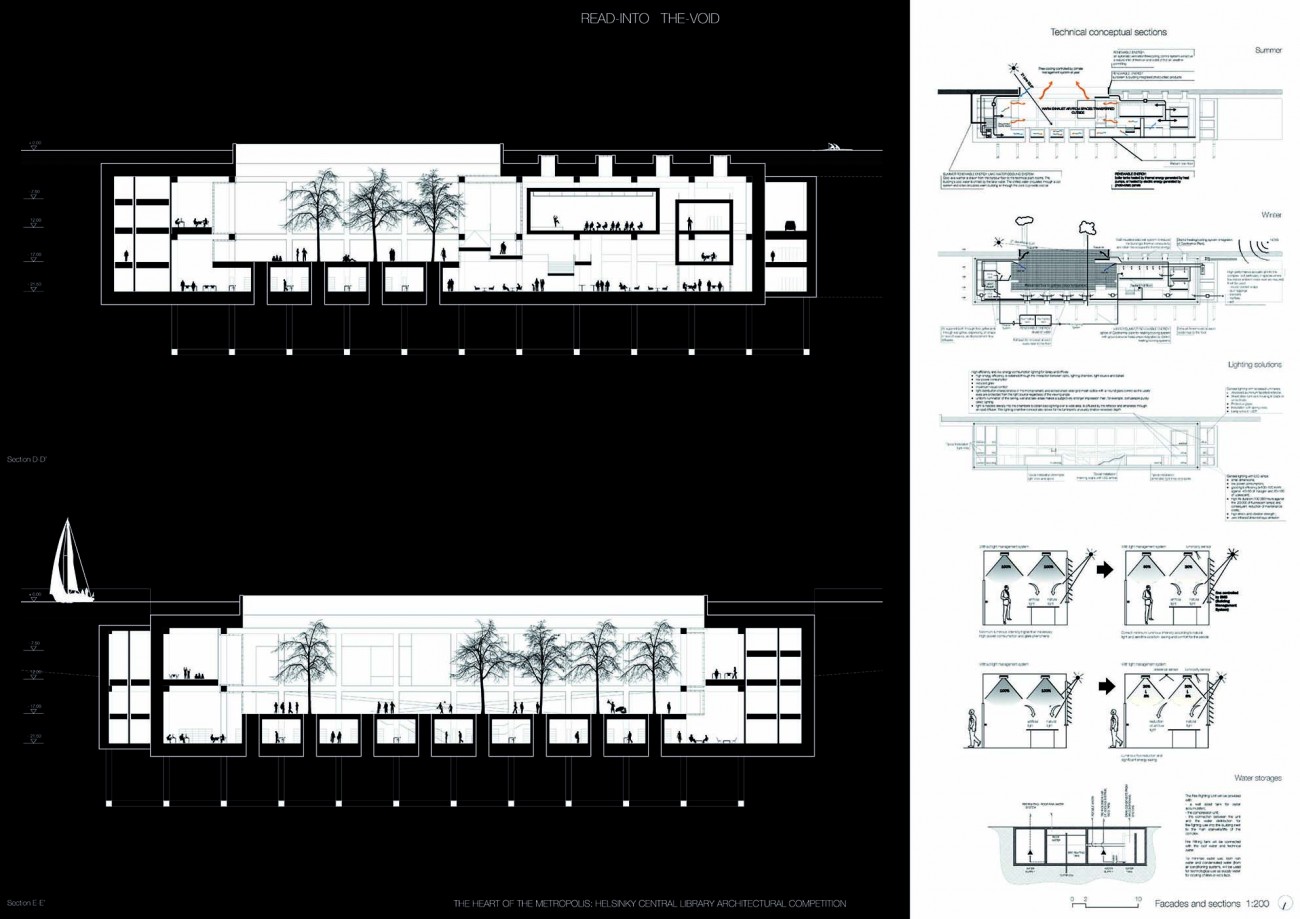
Perciò i 109 metri circa del quadrato si divide in due parti di 44 metri, ritmati dai corpi scala: tre di 7 metri (corpi scala). Mentre, d’altra parte, la stessa misura, 109 metri, si divide in 12 moduli da 8,75 metri.
In conclusione la terra è “toccata” da un’operazione della mente secondo una idea di spazio.
Dunque secondo l’idea, si fa “spazio” sotto terra. E, forando il fondo dell’acqua, attraverso dighe di mura in cemento impermeabile, si realizza un volume “cubico” o semicubico. Così, esso misura un “quanto” di luce dall’alto. Coprendone, poi, la metà si crea uno spazio d’ombra sotto la copertura, illuminata da lucernari, che forano i solai restando coperti da una lamina d’acqua. E si forma una penombra attraversata ma luminostà all’incresparsi dell’acqua.
Non può avere facciata questo vuoto ricavato sott’acqua perchè si vuole tale: vuoto semicoperto e semiscoperto come nel paradigma del foro classico ellenistico-romano. Però sulla mezzeria che stabilisce la soglia d’inversione si ritaglia una via d’accesso, dall’una e dall’altra parte, fino alle piazze o ai lungolago di Helsinki, la città che ha bandito il concorso del 2013.
Dunque dentro il recinto che delimita il vuoto scoperto e coperto si trovano le due modalità primarie o “archetipe” dell’abitare -sotto il cielo o al coperto. I due campi eguali offrendosi entro il recinto abitato per un breve spessore, parimenti all’opzione del pubblico per le diverse ore di sosta. È per di più prevista nella parte coperta la presenza di sale riunione o conferenze e auditorium appesi che sottolineano l’estraneamento estremo dal “mondo” esterno e dalla città concreta con la quale, di fatto, vi è un interfaccia costante.
Insomma Lorenzo degli Esposti si è accollato la sfida concettuale di mettere a punto un paradigma moderno tridimensionale architettonico e di dimostrane la declinabilità, articolandone il modello in modo da soddisfare il bando di concorso per la biblioteca di Helsinki.
La proposta non poteva essere accolta dalla commissione giudicatrice perchè non si collocava nella sede prescritta.
Ma il risultato è egualmente importante perchè elabora uno schema tipologico paradigmatico, cioè il modello tridimensionale declinabile capace di produrre la sinergia (ibridazione nella terminologia di Fenton) di tipologie edilizie diverse.
Stabilisce dunque la sintassi del contenitore moderno articolandolo nelle tre dimensioni in modo da distinguerne le parti in modo essenziale. Lo designa come landmark in negativo, cioè come groundmark . Esso è capace di imprimersi nella memoria come “immagine agente” ; evocatrice di quel “fascio” di “frecce del desiderio” richieste dalla “psicologia sociale”. Un’immagine, ripeto, corrispondente al compito di concentrare il pubblico della biblioteca sul culto del libro.
Infine quale esempio di paradigma architettonico declinabile, questa forma architettonica è capace di essere resa conforme ai vari casi (con diversi programmi d’uso) attraverso operazioni di “variazione conformi al paradigma” come dimostrerò in altri articoli relativi allo studio di altri progetti. Intendo così verificare il percorso verso un’architettura parametrica raggiungibile attraverso la sperimentazione architettonica progettuale sul campo.
Ora lascio agio al lettore di esaminare i disegni.
Ernesto d’Alfonso
READ-INTO THE-VOID THE HEART OF THE METROPOLIS: HELSINKI CENTRAL LIBRARY ARCHITECTURAL COMPETITION
1. Read Into the Void
The intention to build a central library as the heart of the metropolis is exemplary.
The requests of the call in term of cityscape, relationship with public buildings, symbolic significance, timeless architecture, eco-efficiency, are essential.
Töölönlahti is a crucial place for that urban function and for those civic goals.
The specific location seems more problematic.
The town plan for the new urbanization, beside the railways area, shows some critical points which the library might not be able to solve. Moreover, the position of the library, as requested by the call, might constitute a problem even for the library itself, forced to dignify the speculative settlement at the back and to fit in an already strongly congested area. The further idea to accommodate an underground shopping center between the library and the Finnish Parliament building seems inappropriate. On the one hand for the significance of the place. On the other hand for the technical and economical complexity of the excavation in such a narrow space to make room for it.
All these constraints, unsolved by the town plan for Töölönlahti, can be solved in a different way, using the occasion of the international competition for the library.
We agree on the point that nor an office building neither a shopping centre can face the Parliament. But to bury the latter or to hide the former, is not the solution, especially for the social and civic needs of a library, as moreover expressed by the call.
For a while, let’s try to think to the Töölönlahti town plan without the library.
Instead of the library, the shopping center itself can hide the office buildings, by being not only underground, but using spaces over and under the street level and multiplying the commercial areas. The roof of the shopping centre is a green slope, to be used as a garden in summer, and as ski run in winter when it is covered by snow. Children and parents can have fun, in front of the Parliament where their employees are taking care of the Nation. The commercial and office blocks are hidden by the slope, which functions like a green esplanade, as it is appropriate in front of institutional buildings. At the ground level, a complex fabric of urban (outdoor but partially covered) and commercial (indoor) places faces the Kiasma Museum, the Helsinki Music Centre, the Sanomatalo and the new office building beside the railways tracks.
But then, where does the library end up?
In the year 1921, Adolf Loos wrote Ins Leere Gesprochen, Spoken Into the Void, dealing with the abyss that opens in language between the written and the spoken word.
In 1997, Peter Eisenman wrote Written Into the Void, a text later distributed at the MAK exhibition in Vienna, linking Loos’ text to the investigations made by Derrida, Lyotard and Deleuze on the relationship between language and reality, text and objects.
We think that the occasion to build a library in such an unique place as Töölönlahti must be used to investigate that relationship, so that a void can be, physically, the poetic reification of it and the key to explore what is usually hidden and inaccessible.
Read Into the Void.
How to succeed in such an ambitious task?
To do that, we thought to follow precisely the requests of the call, except for the specific location of the new library.
The overall cityscape and in particular the powerful line of public buildings, composed by Kiasma – Music Centre – Hakasalmi villa – Finlandia Hall – National Opera – Olympic Stadium, strongly suggest to line up the new building too. In the year 1560 the Venetian writer and Maecenas Alvise Corner proposed, in the most famous of his projects, to build two little islands in the basin in front of piazza San Marco, one in the form of a theater, the other as an hill topped by a loggia. A similar action seems appropriate for Helsinki: the new library will be positioned in the Töölönlahti bay, in front of the green corridor that visually link westwards the bay with the Seurasaarenselkä. In this way, the attention to the cityscape and the integration in a cohesive totality with the other public buildings are fully satisfied, much more than in the position indicated by the call. The cohesion between all the institutional buildings is enriched by a landscape sign, which take the form of a canal, from the Kiasma beside the new shopping centre on one side and the Finlandia Hall on the other side, through the bay where the library takes place, to the Finnish National Opera building, where it takes the form of a little basin.
The symbolic significance requested by the call suggested us to sink the new library in the bay, so that the entire building is seen as a void in the water. A geometrically shaped void, full of trees. This void is a courtyard, which all the underwater spaces of the library are organized around. The courtyard is accessible through two pedestrian ramps, which are built along the line of the public buildings. Walking from the city centre, people pass near the Kiasma, the Music centre and, close to the Finlandia Hall, they find the beginning of the descending ramp, which gradually sinks into the bay. In this way, the underwater courtyard becomes a public space, linked with the rest of the urban fabric and with the lakefront. This urban and architectonic configuration gives to the library the requested symbolic significance: the library as a poetic realm within the city, abstracted but linked with the urban spaces. Personal cultivation, culture and entertainment will be exploited in a vibrant as well as refined public space.
Moreover in this way the library does not take the form of the usual iconic object, made for the market. The void of the courtyard and of the ramps will be the only visible sign from the land, an artistic sign which represents culture and knowledge, against the commercial use of institutions and architecture. The library as an object is replaced by the library as a land-art sign (courtyard as hole in the water + ramps as cuts in the water).
In this sense we intend the “timeless architecture” and “non-commercial public space – a space for learning, events and experiences” requested by the call.
The library galleries are organized around the courtyard (south, west and north façades), so that they are perfectly illuminated. Beneath the courtyard, a crypto-portico, lit by skylights, accommodates the collections area. The entrance in the library is in the east façade of the courtyard, which divides the external public space of the courtyard and the ramps from the inner public space of the library. At the end of each external ramp (courtyard level) there is an access to the building, which opens to the lobby, a wide space where all the functions are articulated as isolated volumes supported by the structural grid and served by floating footbridges.
Technical and service car access is provided by an underground passage from the street Mannerheimvägen. Other than the pedestrian ramps, the tunnels to Mannerheimvägen are used also as safety paths, to have multiple fire escapes.
The choice to put the building underwater and partially underground offers great advantages in term of eco-efficiency, since the water and ground masses are perfect mediators with the external climate.





